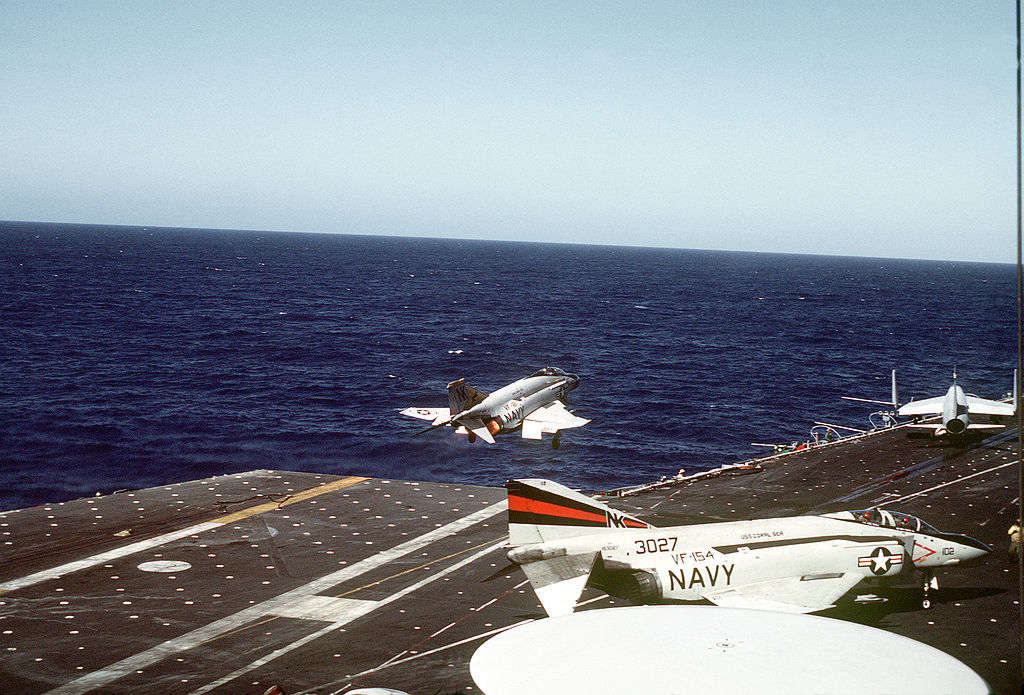“As a veteran of many missile shots, both AIM-9 and AIM-7, this was the most challenging due to the speeds involved and the parameters of the test”
I was a missile project officer at the Naval Missile Center (NMC), located at Point Mugu, California, in January 1974. I served with Fighter Squadron 154 on two combat missions to South East Asia aboard the USS RANGER (CVA-61) (VF154). I worked on the AIM-7 Sparrow, AIM-9 Sidewinder, and AIM-54 Phoenix missile projects’ air-to-air branch. Along with Naval Officers who flew the missions, our branch also had civilian engineers and test pilots.
The first F-4 that was set up as a drone, or unmanned target, is the subject of this tale.
A drone has the prefix “Q”, therefore it is a QF-4. The preparation of the QF-4 for its first Nolo (no live operator) flight took the NMC Target department almost a year. It was planned as the target for a test of the Sidewinder missile with lead bias, which allows the missile to draw lead on an afterburning target fired from the front quarter.
A heat-seeking missile with an expanding rod warhead is called the AIM-9. A live warhead on a missile does not need to strike the target because the missile contains a proximity fuse. The expanding rod will break up and move outward in a conical route as it approaches the target, thereby increasing the kill radius of the missile. It will then explode as it gets close to the target. The missile was intended to be fired from behind and directed at the target’s heat signature.

The Sidewinder and the Sparrow were the only air-to-air weapons available because U.S. Navy F-4s were not equipped with cannons. The radar-guided AIM-7 missile was created to be fired from the forward quarter.
This test missile was planned to be launched from an F-4J (number #153073) equipped with a unique digital AWG-10 radar and would not carry a warhead. The AWG-10 could be used to configure the test’s parameters, and the missile couldn’t be launched unless the conditions were met. The QF-4 was to fly throughout the test at 1.4 Mach, while the launch F-4J was to fly at 1.4 Mach with a 140-degree track crossing angle. The distance between the two aircraft was to be 20,000 feet. With a Sidewinder lock on and a target + or – 5 degrees off the nose of the F-4J, the launch distance was between 20,000 and 24,000 feet.
In addition, a USAF ALOTS (Airborne Light Optical Tracking System) aircraft was flying seven miles behind the QF-4 in a parallel course at a speed of about .7 Mach. The task of the ALOTS aircraft was to take pictures of the test. Test pilots at the Naval Missile Center were in control of each aircraft and telemetered it.
Prior to the scheduled test, the air-to-air branch’s engineers did computer simulations that revealed the missile would pass behind the QF-4 but would be in the deadly range of a Sidewinder warhead. The Naval Air Systems Command (NAVAIR) and the NMC Threat simulation department were persuaded by these simulations that the missile would miss and not damage the priceless QF-4.
Overlooking the Pacific Ocean, the missile test was being carried out on the Pacific Missile Range. Getting all three aircraft at the correct location at the same time presented a problem for the NMC test conductors. Thursday, January 31, 1974, was the scheduled day for the live range time. The dates of the practices were January 29 and 30. Due to the inherent challenge of getting all three airplanes in the right position at the same time, the parameters were never reached during the two practices.
I was part of the flight crew together with Cdr. Head of the air-to-air branch Pete Brown. We received our regular briefing with the test conductors and the flying crews on the morning of January 31. As expected, everything happened. The controllers had lined us up perfectly; all three aircraft were in the proper positions, and as we drew near, we received a Sidewinder tone indicating lock up on the target. We quickly crossed the firing range due to our closing speed, and the missile fired. We stopped, crossed over behind the QF-4’s flight path, and watched as it exploded as its wreckage fell to the ground. The Sidewinder struck the QF4 directly in the middle, constituting a direct hit. We were overjoyed and eager to land and review the flight.
The Air Force ALOTS crew couldn’t believe the amazing view they had. Except for the Threat Simulation Department, which had recently lost its expensive QF-4, everyone was ecstatic about the missile’s successful lead bias performance.
Due to the speeds involved and the test’s requirements, this was the most difficult missile shoot I had ever attempted. I had fired both AIM-9 and AIM-7 missiles before. This test was a success because of the diligence of all those engaged, including the engineers, test operators, air traffic controllers, and the USAF ALOTS crew.

Top image: U.S. Air Force via Ken Forbes; Bottom image: Lt. Pat Noonan / U.S. Navy via Ken Forbes
VF-154 F-4J photo: PH2 ROBERT S. SWINLAND / U.S. Navy

